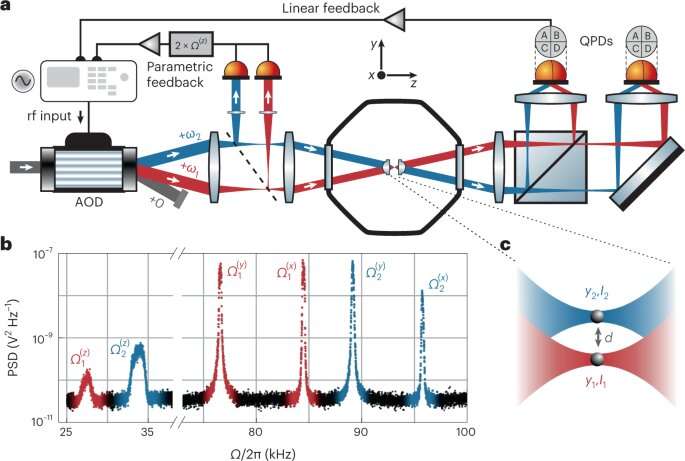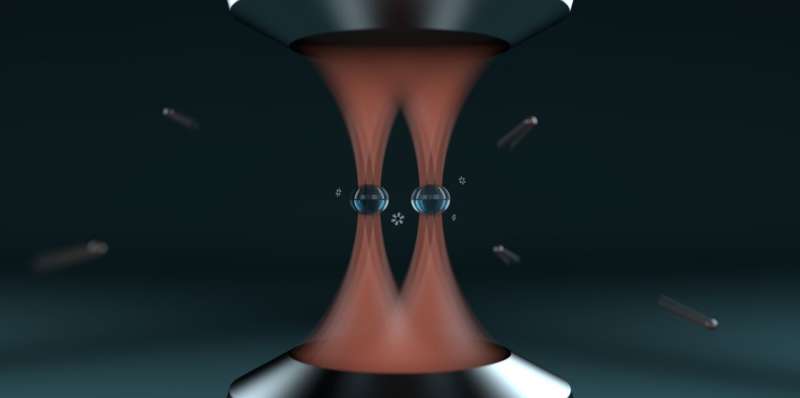Cooling nanoparticles simultaneously independently of their electric charge

 Nature Nanotechnology (2022). DOI: 10.1038/s41565-022-01254-6″ width=”685″ height=”461″>
Nature Nanotechnology (2022). DOI: 10.1038/s41565-022-01254-6″ width=”685″ height=”461″>Over the past forty years, physicists have learned to cool increasingly large objects down to temperatures close to the absolute zero: atoms, molecules and, more recently, also nanoparticles consisting of billions of atoms. Whereas one can cool atoms with laser light alone, up to now nanoparticles needed to have an electric charge and had to be manipulated using electric fields for optimal cooling.
A team of ETH researchers led by Professor Lukas Novotny at the Department of Information Technology and Electrical Engineering has now developed a technique to trap and cool several nanoparticles independently of their electric charge down to a few millikelvin. This opens up various possibilities to study quantum phenomena of such particles or to build highly sensitive sensors.
Cooling neutral particles
“In our research group we have perfected the cooling of single electrically charged nanoparticles over the past ten years”, says Jayadev Vijayan, a postdoc in Novotny’s laboratory and lead author of the paper recently published in the scientific journal Nature Nanotechnology. “With the new method, which also works for electrically neutral objects, we can now also trap several particles simultaneously for the first time, which opens up entirely new perspectives for research.”
In their experiments the researchers trapped a tiny glass sphere a little less than 200 nanometers in size using a strongly focused laser beam, also known as an optical tweezer, inside a vacuum apparatus. Inside the optical tweezer the sphere oscillates back and forth due to its motional energy.
The higher the temperature of the particle, the higher its motional energy and hence the amplitude of oscillation. How strongly and in which direction the sphere is oscillating inside the optical tweezer at a given moment can be measured using a light detector, which captures the laser light scattered by the sphere.

Slowing down by shaking
Novotny and his collaborators then use that information to slow down the nanoparticle and, therefore, cool it. This is achieved by shaking the optical tweezer in exactly the opposite sense with respect to the oscillation of the sphere using an electronically controlled deflector that slightly changes the direction of the laser beam and hence the position of the tweezer.
When the sphere moves to the left, the tweezer is quickly shifted to the right in order to counteract the motion of the sphere; when it moves to the right, the deflector shifts the tweezer to the left. In this way, its oscillation amplitude, and hence its effective temperature, is reduced little by little—all the way down to a few thousandths of a degree above the absolute zero of -273.15 degrees Celsius.
To cool two nanoparticles at the same time the researchers use a trick. The optical tweezers in which they trap the spheres are adjusted such that the oscillation frequencies of the particles are slightly different. In that way, the motions of the two spheres can be distinguished using the same light detector, and the cooling-down strategies can be applied separately to the two tweezers.
Scaling up to several nanoparticles
“The simultaneous cooling can be straightforwardly scaled up to several nanoparticles,” Vijayan explains. “Since we have full control over the positions of the particles, we can arbitrarily tune the interactions between them; in that way, in the future we can study quantum effects of several particles, such as entanglement.”
In an entangled state, a measurement on one particle instantaneously influences the quantum state of the other one without any direct contact between the two particles. Up to now such states have been realized mainly with photons or single atoms. Vijayan hopes that one day he will be able to also create entangled states with the much larger nanoparticles.
The fact that the nanoparticles can be electrically neutral has further advantages, for instance for the development of extremely sensitive sensors. When measuring very weak gravitational forces between objects or searching for hypothetical dark matter, one would like to eliminate other forces as much as possible—and most often, those are electrostatic forces between charged particles. The method developed by the ETH researchers promises new insights in those fields, too.
More information:
Jayadev Vijayan, Scalable all-optical cold damping of levitated nanoparticles, Nature Nanotechnology (2022). DOI: 10.1038/s41565-022-01254-6. www.nature.com/articles/s41565-022-01254-6
Provided by
ETH Zurich
Citation:
Cooling nanoparticles simultaneously independently of their electric charge (2022, November 21)
retrieved 21 November 2022
from https://phys.org/news/2022-11-cooling-nanoparticles-simultaneously-independently-electric.html
This document is subject to copyright. Apart from any fair dealing for the purpose of private study or research, no
part may be reproduced without the written permission. The content is provided for information purposes only.


